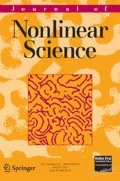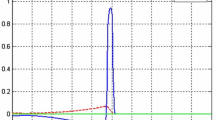Abstract
The FitzHugh–Nagumo equations are known to admit fast traveling pulses that have monotone tails and arise as the concatenation of Nagumo fronts and backs in an appropriate singular limit, where a parameter \(\varepsilon \) goes to zero. These pulses are known to be nonlinearly stable with respect to the underlying PDE. Recently, the existence of fast pulses with oscillatory tails was proved for the FitzHugh–Nagumo equations. In this paper, we prove that the fast pulses with oscillatory tails are also nonlinearly stable. Similar to the case of monotone tails, stability is decided by the location of a nontrivial eigenvalue near the origin of the PDE linearization about the traveling pulse. We prove that this real eigenvalue is always negative. However, the expression that governs the sign of this eigenvalue for oscillatory pulses differs from that for monotone pulses, and we show indeed that the nontrivial eigenvalue in the monotone case scales with \(\varepsilon \), while the relevant scaling in the oscillatory case is \(\varepsilon ^{2/3}\).









Similar content being viewed by others
References
Beck, M., Jones, C.K.R.T., Schaeffer, D., Wechselberger, M.: Electrical waves in a one-dimensional model of cardiac tissue. SIAM J. Appl. Dyn. Syst. 7(4), 1558–1581 (2008)
Carpenter, G.: A geometric approach to singular perturbation problems with applications to nerve impulse equations. J. Differ. Equ. 23(3), 335–367 (1977)
Carter, P., Sandstede, B.: Fast pulses with oscillatory tails in the FitzHugh–Nagumo system. SIAM J. Math. Anal. 47(5), 3393–3441 (2015)
Coppel, W.A.: Dichotomies and reducibility. J. Differ. Equ. 3, 500–521 (1967)
Coppel, W.A.: Dichotomies in Stability Theory, Volume 629 of Lecture Notes in Mathematics. Springer, Berlin (1978)
Eszter, E.G.: An Evans function analysis of the stability of periodic travelling wave solutions of the FitzHugh–Nagumo system. PhD thesis, University of Massachusetts (1999)
Evans, J.W.: Nerve axon equations. I. Linear approximations. Indiana Univ. Math. J. 21, 877–885 (1971/1972)
Evans, J.W.: Nerve axon equations. III. Stability of the nerve impulse. Indiana Univ. Math. J. 22, 577–593 (1972/1973)
Fenichel, N.: Geometric singular perturbation theory for ordinary differential equations. J. Differ. Equ. 31(1), 53–98 (1979)
FitzHugh, R.: Impulses and physiological states in theoretical models of nerve membrane. Biophys. J. 1(6), 445 (1961)
Flores, G.: Stability analysis for the slow travelling pulse of the FitzHugh–Nagumo system. SIAM J. Math. Anal. 22(2), 392–399 (1991)
Hastings, S.P.: On the existence of homoclinic and periodic orbits for the FitzHugh–Nagumo equations. Q. J. Math. 27(1), 123–134 (1976)
Hastings, S.P.: Single and multiple pulse waves for the Fitzhugh–Nagumo. SIAM J. Appl. Math. 42(2), 247–260 (1982)
Holzer, M., Doelman, A., Kaper, T.J.: Existence and stability of traveling pulses in a reaction–diffusion-mechanics system. J. Nonlinear Sci. 23(1), 129–177 (2013)
Homburg, A.J., & Sandstede, B.: Homoclinic and heteroclinic bifurcations in vector fields. In: Broer, H., Takens, F., Hasselblatt, B. (eds.) Handbook of Dynamical Systems III, pp 379–524. Elsevier (2010)
Hupkes, H.J., Sandstede, B.: Stability of pulse solutions for the discrete FitzHugh–Nagumo system. Trans. Am. Math. Soc. 365(1), 251–301 (2013)
Jones, C.K.R.T.: Stability of the travelling wave solution of the FitzHugh–Nagumo system. Trans. Am. Math. Soc. 286(2), 431–469 (1984)
Jones, C.K.R.T., Kaper, T.J., Kopell, N.: Tracking invariant manifolds up to exponentially small errors. SIAM J. Math. Anal. 27(2), 558–577 (1996)
Jones, C.K.R.T., Kopell, N., Langer, R.: Construction of the FitzHugh–Nagumo pulse using differential forms. In: Patterns and Dynamics in Reactive Media, pp. 101–115. Springer (1991)
Kapitula, T., Promislow, K.: Spectral and Dynamical Stability of Nonlinear Waves, volume 185 of Applied Mathematical Sciences. Springer, New York (2013). With a foreword by C. K. R. T Jones
Krupa, M., Sandstede, B., Szmolyan, P.: Fast and slow waves in the FitzHugh–Nagumo equation. J. Differ. Equ. 133(1), 49–97 (1997)
Krupa, M., Szmolyan, P.: Extending geometric singular perturbation theory to nonhyperbolic points—fold and canard points in two dimensions. SIAM J. Math. Anal. 33(2), 286–314 (2001)
Krupa, M., Szmolyan, P.: Relaxation oscillation and canard explosion. J. Differ. Equ. 174(2), 312–368 (2001)
Levinson, N.: The asymptotic nature of solutions of linear systems of differential equations. Duke Math. J. 15, 111–126 (1948)
Lin, X.B.: Using Melnikov’s method to solve Šilnikov’s problems. Proc. R. Soc. Edinb. Sect. A 116(3–4), 295–325 (1990)
Mishchenko, E.: Differential Equations with Small Parameters and Relaxation Oscillations, vol. 13. Springer Science & Business Media, Berlin (2013)
Nagumo, J., Arimoto, S., Yoshizawa, S.: An active pulse transmission line simulating nerve axon. Proc. IRE 50(10), 2061–2070 (1962)
Palmer, K.J.: Exponential dichotomies and transversal homoclinic points. J. Differ. Equ. 55(2), 225–256 (1984)
Sandstede, B.: Verzweigungstheorie homokliner Verdopplungen. PhD thesis, University of Stuttgart (1993)
Sandstede, B.: Stability of multiple-pulse solutions. Trans. Am. Math. Soc. 350(2), 429–472 (1998)
Sandstede, B.: Stability of travelling waves. In: Fiedler, B.(ed.) Handbook of Dynamical Systems, vol. 2, pp. 983–1055. Elsevier (2002)
Sandstede, B., Scheel, A.: Absolute and convective instabilities of waves on unbounded and large bounded domains. Phys. D 145(3–4), 233–277 (2000)
Yanagida, E.: Stability of fast travelling pulse solutions of the FitzHugh–Nagumo equations. J. Math. Biol. 22(1), 81–104 (1985)
Acknowledgments
Carter was supported by the NSF under Grant DMS-1148284. De Rijk was supported by the Dutch science foundation (NWO) cluster NDNS+. Sandstede was partially supported by the NSF through Grant DMS-1409742.
Conflict of interest
The authors declare that they have no conflict of interest.
Author information
Authors and Affiliations
Corresponding author
Additional information
Communicated by Michael Ward.
Appendices
Appendix 1: Corner Estimates
In this section, we provide a proof of Theorem 4.5, based on a theorem in Eszter (1999), regarding the nature of solutions upon entry to a neighborhood of a slow manifold.
Proof of Theorem 4.5
This proof is based on an argument in Eszter (1999). In the box
for sufficiently small \(\varepsilon >0\), there exist constants \(\alpha ^{u/s}_\pm >0\) such that
We first consider the V-coordinate. For any \(\xi >\xi _1\), we have
Since \(V(\xi _2)\in N_2\), we also have
We note that since the solution enters \(\mathcal {U}_E'\) via \(N_1\) and reaches \(N_2\) at \(\xi _2(\varepsilon )\), using the equation for W in (3.9), we have that \(\xi _2(\varepsilon )\) satisfies \(\xi _2(\varepsilon )\ge (C\varepsilon )^{-1}\). Therefore, using the upper bound on \(\Gamma \) we have that
for \(\xi \in \left[ \xi _1,\Xi (\varepsilon )\right] \).
The solution in the slow W-component may be written as
from which we infer that
and hence
Finally, we consider the U-component. We have that the difference \((U(\xi )-U_0(\xi ))\) satisfies
with \(U(\xi _1)-U_0(\xi _1)=\tilde{U}_0\) where \(|\tilde{U}_0|\ll \Delta \). By possibly taking \(\Delta \) smaller if necessary and using the fact that the rate of contraction in the U-component is stronger than \(\alpha ^s_-\), we deduce that \((U(\xi )-U_0(\xi ))\) satisfies a differential equation
where \(b_1(\xi )<-\alpha ^s_-/2<0\) and
for \(\xi \in \left[ \xi _1,\Xi (\varepsilon )\right] \). Hence, it holds
for \(\xi \in \left[ \xi _1,\Xi (\varepsilon )\right] \), which completes the proof. \(\square \)
Appendix 2: Exponential Dichotomies and Trichotomies
It is well known that exponential separation is an important tool in studying spectral properties of traveling waves Sandstede (2002). Below we provide the definitions of exponential dichotomies and trichotomies to familiarize the reader with our notation. For an extensive introduction, we refer to Coppel (1978), Sandstede (1993).
Definition 9.1
Let \(n \in \mathbb {Z}_{> 0}\), \(J \subset \mathbb {R}\) an interval and \(A \in C(J,\mathrm {Mat}_{n \times n}(\mathbb {C}))\). Denote by T(x, y) the evolution operator of
Equation (9.2) has an exponential dichotomy on J with constants \(K,\mu > 0\) and projections \(P^s(x), P^u(x) :\mathbb {C}^n \rightarrow \mathbb {C}^n, x \in J\) if for all \(x,y \in J\) it holds
-
\(P^u(x) + P^s(x) = 1\);
-
\(P^{u,s}(x)T(x,y) = T(x,y) P^{u,s}(y)\);
-
\(\Vert T(x,y)P^s(y)\Vert , \Vert T(y,x)P^u(x)\Vert \le Ke^{-\mu (x-y)}\) for \(x \ge y\).
Equation (9.2) has an exponential trichotomy on J with constants \(K,\mu ,\nu > 0\) and projections \(P^u(x),P^s(x),P^c(x):\mathbb {C}^n \rightarrow \mathbb {C}^n, x \in J\) if for all \(x,y \in J\) it holds
-
\(P^u(x) + P^s(x) + P^c(x) = 1\);
-
\(P^{u,s,c}(x)T(x,y) = T(x,y) P^{u,s,c}(y)\);
-
\(\Vert T(x,y)P^s(y)\Vert , \Vert T(y,x)P^u(x)\Vert \le Ke^{-\mu (x-y)}\) for \(x \ge y\);
-
\(\Vert T(x,y)P^c(y)\Vert \le Ke^{\nu |x-y|}\).
Often we use the abbreviations \(T^{u,s,c}(x,y) = T(x,y)P^{u,s,c}(y)\) leaving the associated projections of the dichotomy or trichotomy implicit.
Rights and permissions
About this article
Cite this article
Carter, P., de Rijk, B. & Sandstede, B. Stability of Traveling Pulses with Oscillatory Tails in the FitzHugh–Nagumo System. J Nonlinear Sci 26, 1369–1444 (2016). https://doi.org/10.1007/s00332-016-9308-7
Received:
Accepted:
Published:
Issue Date:
DOI: https://doi.org/10.1007/s00332-016-9308-7
Keywords
- FitzHugh-Nagumo system
- traveling pulses
- spectral stability
- geometric singular perturbation theory
- Lin’s method



